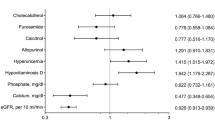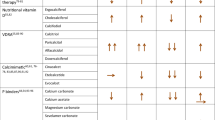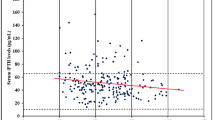Abstract
Purpose
As the world’s population ages, the incidence of chronic kidney disease (CKD) is growing. There is ongoing debate regarding whether high levels of parathyroid hormone (PTH) would be more common in elderly than young patients, and which factors are driven the risk of secondary hyperparathyroidism (SHPT), independent of renal function.
Methods
Elderly patients (age ≥ 65 years, N = 518) were compared to a 1:1 sex- and estimated glomerular filtration rate (eGFR)-matched sample of young patients (age < 65 years), in a cross-sectional analysis. Demographic, biochemical and drug prescription data were collected from electronic charts. The main outcome measure was the prevalence of SHPT, defined as PTH > 65 pg/mL.
Results
Elderly patients presented higher serum calcium and PTH levels and lower serum phosphate, and were taking more diuretics than young patients. SHPT was more frequent among elderly patients (49.4 vs. 38.6%, p = 0.005), and it was associated with lower eGFR, low levels of 25(OH) vitamin D and with furosemide therapy, while thiazide use was a protector factor. Elderly patients with 25(OH) vitamin D > 40 ng/mL were protected against SHPT. The Ca/PTH ratio was lower in elderly than in young patients [0.15 (0.10, 0.20) vs. 0.16 (0.11, 0.23), respectively, p = 0.003].
Conclusion
CKD elderly patients have higher risk of SHPT than young, which cannot be explained solely by renal function. Besides low levels of vitamin D, furosemide therapy and a distinct relationship between calcium and PTH are possible factors contributing to SHPT. Whether this is a result of renal resistance to PTH or an altered set point to calcium deserves further investigation.


Similar content being viewed by others
References
Organization WH (2015) http://www.who.int/mediacentre/factsheets/fs404/en/. http://www.who.int/mediacentre/factsheets/fs404/en/
Mills KT, Xu Y, Zhang W, Bundy JD, Chen CS, Kelly TN, Chen J, He J (2015) A systematic analysis of worldwide population-based data on the global burden of chronic kidney disease in 2010. Kidney Int 88(5):950–957. doi:10.1038/ki.2015.230
Baber U, Gutierrez OM, Levitan EB, Warnock DG, Farkouh ME, Tonelli M, Safford MM, Muntner P (2013) Risk for recurrent coronary heart disease and all-cause mortality among individuals with chronic kidney disease compared with diabetes mellitus, metabolic syndrome, and cigarette smokers. Am Heart J 166 (2):373-380 e372. doi:10.1016/j.ahj.2013.05.008
Hallan S, Astor B, Romundstad S, Aasarod K, Kvenild K, Coresh J (2007) Association of kidney function and albuminuria with cardiovascular mortality in older vs younger individuals: the HUNT II study. Arch Intern Med 167(22):2490–2496. doi:10.1001/archinte.167.22.2490
O’Hare AM, Choi AI, Bertenthal D, Bacchetti P, Garg AX, Kaufman JS, Walter LC, Mehta KM, Steinman MA, Allon M, McClellan WM, Landefeld CS (2007) Age affects outcomes in chronic kidney disease. J Am Soc Nephrol 18(10):2758–2765. doi:10.1681/ASN.2007040422
Babayev R, Nickolas TL (2015) Bone disorders in chronic kidney disease: an update in diagnosis and management. Semin Dial 28(6):645–653. doi:10.1111/sdi.12423
Fung E, Kurella Tamura M (2016) Epidemiology and public health concerns of CKD in older adults. Adv Chronic Kidney Dis 23(1):8–11. doi:10.1053/j.ackd.2015.10.001
Haden ST, Brown EM, Hurwitz S, Scott J, El-Hajj Fuleihan G (2000) The effects of age and gender on parathyroid hormone dynamics. Clin Endocrinol (Oxf) 52(3):329–338
Vasco RF, Moyses RM, Zatz R, Elias RM (2016) Furosemide increases the risk of hyperparathyroidism in chronic kidney disease. Am J Nephrol 43(6):421–430. doi:10.1159/000446449
Puttnam R, Davis BR, Pressel SL, Whelton PK, Cushman WC, Louis GT, Margolis KL, Oparil S, Williamson J, Ghosh A, Einhorn PT, Barzilay JI, Antihypertensive, Lipid-Lowering Treatment to Prevent Heart Attack Trial Collaborative Research G (2017) Association of 3 different antihypertensive medications with hip and pelvic fracture risk in older adults: secondary analysis of a randomized clinical trial. JAMA Intern Med 177(1):67–76. doi:10.1001/jamainternmed.2016.6821
Levey AS, Stevens LA, Schmid CH, Zhang YL, Castro AF 3rd, Feldman HI, Kusek JW, Eggers P, Van Lente F, Greene T, Coresh J, Ckd EPI (2009) A new equation to estimate glomerular filtration rate. Ann Intern Med 150(9):604–612
Lindblom P, Valdemarsson S, Lindergard B, Westerdahl J, Bergenfelz A (2001) Decreased levels of ionized calcium one year after hemithyroidectomy: importance of reduced thyroid hormones. Horm Res 55(2):81–87. doi:10.1159/000049975
Olmos JM, Hernandez JL, Garcia-Velasco P, Martinez J, Llorca J, Gonzalez-Macias J (2016) Serum 25-hydroxy vitamin D, parathyroid hormone, calcium intake, and bone mineral density in Spanish adults. Osteoporos Int 27(1):105–113. doi:10.1007/s00198-015-3219-6
Sprague SM, Coyne D (2010) Control of secondary hyperparathyroidism by vitamin D receptor agonists in chronic kidney disease. Clin J Am Soc Nephrol 5(3):512–518. doi:10.2215/CJN.03850609
Clemens TL, Zhou XY, Myles M, Endres D, Lindsay R (1986) Serum vitamin D2 and vitamin D3 metabolite concentrations and absorption of vitamin D2 in elderly subjects. J Clin Endocrinol Metab 63(3):656–660. doi:10.1210/jcem-63-3-656
Gallagher JC, Riggs BL, Eisman J, Hamstra A, Arnaud SB, DeLuca HF (1979) Intestinal calcium absorption and serum vitamin D metabolites in normal subjects and osteoporotic patients: effect of age and dietary calcium. J Clin Invest 64(3):729–736. doi:10.1172/JCI109516
Vieth R, Ladak Y, Walfish PG (2003) Age-related changes in the 25-hydroxy vitamin D versus parathyroid hormone relationship suggest a different reason why older adults require more vitamin D. J Clin Endocrinol Metab 88(1):185–191. doi:10.1210/jc.2002-021064
Bellorin-Font E, Ambrosoni P, Carlini RG, Carvalho AB, Correa-Rotter R, Cueto-Manzano A, Jara A, Jorgetti V, Negri AL, Olaizola I, Salusky I, Slatopolsky E, Weisinger JR, Comite de Metabolismo Mineral y O, Sociedad Latinoamericana de Nefrologia e H (2013) Clinical practice guidelines for the prevention, diagnosis, evaluation and treatment of mineral and bone disorders in chronic kidney disease (CKD-MBD) in adults. Nefrologia 33(Suppl 1):1–28. doi:10.3265/Nefrologia.pre2013.Feb.11945
Anderson F (2005) Vitamin D for older people: How much, for whom and—above all—why? Age Ageing 34(5):425–426. doi:10.1093/ageing/afi147
Lips P (2001) Vitamin D deficiency and secondary hyperparathyroidism in the elderly: consequences for bone loss and fractures and therapeutic implications. Endocr Rev 22(4):477–501. doi:10.1210/edrv.22.4.0437
Isakova T, Anderson CA, Leonard MB, Xie D, Gutierrez OM, Rosen LK, Theurer J, Bellovich K, Steigerwalt SP, Tang I, Anderson AH, Townsend RR, He J, Feldman HI, Wolf M, Chronic Renal Insufficiency Cohort Study G (2011) Diuretics, calciuria and secondary hyperparathyroidism in the chronic renal insufficiency cohort. Nephrol Dial Transplant 26(4):1258–1265. doi:10.1093/ndt/gfr026
Stein MS, Scherer SC, Walton SL, Gilbert RE, Ebeling PR, Flicker L, Wark JD (1996) Risk factors for secondary hyperparathyroidism in a nursing home population. Clin Endocrinol (Oxf) 44(4):375–383
Muller ME, Forni Ogna V, Maillard M, Stoudmann C, Zweiacker C, Anex C, Wuerzner G, Burnier M, Bonny O (2015) Furosemide stimulation of parathormone in humans: role of the calcium-sensing receptor and the renin-angiotensin system. Pflugers Arch 467(12):2413–2421. doi:10.1007/s00424-015-1714-4
Laurain E, Ayav C, Erpelding ML, Kessler M, Briancon S, Brunaud L, Frimat L (2014) Targets for parathyroid hormone in secondary hyperparathyroidism: Is a “one-size-fits-all” approach appropriate? A prospective incident cohort study. BMC Nephrol 15:132. doi:10.1186/1471-2369-15-132
Kidney Disease: Improving Global Outcomes CKDMBDWG (2009) KDIGO clinical practice guideline for the diagnosis, evaluation, prevention, and treatment of Chronic Kidney Disease-Mineral and Bone Disorder (CKD-MBD). Kidney Int Suppl 113:S1–S130. doi:10.1038/ki.2009.188
Acknowledgements
We thank Fatima Libânio for her assistance in collecting the electronic data.
Author information
Authors and Affiliations
Contributions
RME conceived the study, participated in acquisition of data, design of the study, performed statistical analysis, interpretation of data, preparation of manuscript, read and approved the final manuscript. RMAM participated in the design of the study, interpretation of data, preparation of manuscript, read and approved the final manuscript.
Corresponding author
Ethics declarations
Conflict of interest
The authors declare that they have no competing interest.
Ethical approval
All procedures performed in studies involving human participants were in accordance with the ethical standards of the institutional and/or national research committee and with the 1964 Helsinki Declaration and its later amendments or comparable ethical standards.
Funding
Research in the laboratory of RMAM is supported by CNPQ, Conselho Nacional de Desenvolvimento Científico e Tecnológico (Grant Number 304249/2013-0).
Informed consent
For this type of study (retrospective), formal consent is not required.
Rights and permissions
About this article
Cite this article
Elias, R.M., Moysés, R.M.A. Elderly patients with chronic kidney disease have higher risk of hyperparathyroidism. Int Urol Nephrol 49, 1815–1821 (2017). https://doi.org/10.1007/s11255-017-1650-7
Received:
Accepted:
Published:
Issue Date:
DOI: https://doi.org/10.1007/s11255-017-1650-7




